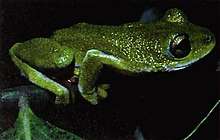Hyperolius occidentalis
Hyperolius occidentalis is a species of frog in the family Hyperoliidae. Its common name is western reed frog. It is found in the coastal lowlands of westernmost West Africa in Senegal, the Gambia, Guinea-Bissau, Guinea, and Sierra Leone.[1][2][3][4]
| Hyperolius occidentalis | |
|---|---|
 | |
| Scientific classification | |
| Kingdom: | Animalia |
| Phylum: | Chordata |
| Class: | Amphibia |
| Order: | Anura |
| Family: | Hyperoliidae |
| Genus: | Hyperolius |
| Species: | H. occidentalis |
| Binomial name | |
| Hyperolius occidentalis Schiøtz, 1967 | |
Description
Males measure 19–29 mm (0.75–1.14 in) and females 29–34 mm (1.1–1.3 in) in snout–vent length.[4] The dorsum is green and may have a darker hourglass pattern. The toes and thighs are reddish. The pupils are horizontal. The toes and fingers have circummarginal disks.[5] The male advertisement call is a double or triple "click".[4] In the Bissagos Islands, the species was found in vegetation about half a meter above the ground, mostly on leaf surfaces or twigs of shrubs. During the heat of the day, they may assume a characteristic resting position to reduce water loss.[6]
Hyperolius occidentalis is very similar to Hyperolius picturatus and the two might even be the same species,[2] perhaps with H. occidentalis being a western subspecies of H. picturatus.[4]
Habitat and conservation
Hyperolius occidentalis lives in heavily degraded former forests (farm bush) within the forest zone, and in gallery forests within the savanna zone. It also occurs on cultivated land, such as irrigated rice fields. Breeding takes place in temporary and permanent pools.[1]
Hyperolius occidentalis is a very common species. It is adaptable, unlikely to face any significant threats, and probably occurs in several protected areas. The International Union for Conservation of Nature (IUCN) has assessed it as of "Least Concern".[1]
References
- IUCN SSC Amphibian Specialist Group (2013). "Hyperolius occidentalis". IUCN Red List of Threatened Species. 2013: e.T56173A18380133. doi:10.2305/IUCN.UK.2013-2.RLTS.T56173A18380133.en.
- Frost, Darrel R. (2016). "Hyperolius occidentalis Schiøtz, 1967". Amphibian Species of the World: an Online Reference. Version 6.0. American Museum of Natural History. Retrieved 29 October 2016.
- "Hyperolius occidentalis Schiøtz, 1967". African Amphibians. Retrieved 29 October 2016.
- "Hyperolius occidentalis". AmphibiaWeb: Information on amphibian biology and conservation. [web application]. Berkeley, California: AmphibiaWeb. 2002. Retrieved 29 October 2016.
- Mol, R.; Westra, S. (November 2015). "Small terrestrial mammal and amphibian survey Boé region, Guinea-Bissau" (PDF). Hoog-Keppel, the Netherlands: Silvavir Forest Consultants. Retrieved 29 October 2016.
- Auliya, Mark; Wagner, Philipp; Böhme, Wolfgang (December 2012). "The herpetofauna of the Bijagós archipelago, Guinea-Bissau (West Africa) and a first country-wide checklist" (PDF). Bonn Zoological Bulletin. 61 (2): 255–281.
